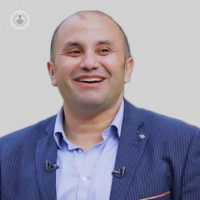Optimising Rehabilitation After Arm Surgery: Tips for a Quick Recovery (Part 1)
Escrito por:Although arm surgery can significantly impact a patient’s daily life, quick and effective rehabilitation can help minimise this effect. There are many proven programmes available, based on evidence, training and surgical techniques. Based on published evidence, surgeons follow specific protocols to ensure the most effective post-operative rehabilitation and quick recovery after surgery.
Professor Mohamed Imam is a distinguished consultant orthopaedic surgeon who specialises in upper limb surgery. In the first of a two-part series of articles on rehabilitation after arm surgery, Professor Imam provides a comprehensive insight into what are the most effective ways to optimise rehabilitation after arm surgery and how setting realistic goals can help during the recovery process.

Quick rehabilitation after arm surgery
The goal of rehabilitation after arm surgery is to restore range of motion, strength and arm function, allowing the patient to return to daily activities as soon as possible.
Here are some tips to help optimise rehabilitation after arm surgery:
- Set rehabilitation goals and track progress: Setting specific, measurable goals and tracking progress can help to optimise rehabilitation after arm surgery. This can include goals for motion, strength and function. Keeping track of progress can help to monitor and motivate the patient to continue with rehabilitation.
- Incorporate technology and wearable devices: Incorporating technology and wearable devices, such as physiotherapy apps, wearable sensors and virtual reality systems, can aid in optimising rehabilitation after arm surgery. These tools can provide real-time feedback on motion, strength and function, as well as help to track progress.
- Focus on range of motion exercises: Range of motion exercises are critical to rehabilitation after arm surgery. These exercises can help to restore flexibility and reduce the risk of stiffness and scar tissue formation. It is important to follow the rehabilitation plan prescribed by the surgeon and physiotherapist, and to avoid overdoing it.
- Strengthening exercises: Strength exercises can help to improve the shoulder joint's stability and reduce the risk of injury. These exercises can include simple weightlifting and resistance band exercises, and can be performed as soon as the surgeon and physiotherapist approve.
- Overcome common setbacks and challenges: Common setbacks and challenges faced during rehabilitation after arm surgery include pain, stiffness and weakness. It is important to address these issues early on and work with the physiotherapist to develop a plan to overcome them. In some cases, medication and/or nerve blocks may be used to manage pain during rehabilitation.
What are the most effective ways to optimise rehabilitation after arm surgery?
The most effective ways to optimise rehabilitation after arm surgery include:
- Setting specific, measurable rehabilitation goals and tracking progress.
- Incorporating technology and wearable devices, such as physical therapy apps, wearable sensors and virtual reality systems, to provide real-time feedback and monitor progress.
- Focusing on range of motion exercises to restore flexibility and reduce the risk of stiffness and scar tissue formation.
- Strengthening the arm and shoulder through weightlifting, resistance band exercises and other strength-building exercises.
- Overcoming common setbacks and challenges, such as pain, stiffness and weakness, by working with the physiotherapist to develop a plan, and using pain management techniques, such as medication or nerve blocks, if needed.
- Following the rehabilitation plan the surgeon and physiotherapist prescribe, and avoiding overdoing it.
Working closely with a surgeon and physiotherapist to develop a personalised rehabilitation plan that considers each patient's specific needs and goals is important.
How can setting rehabilitation goals and tracking progress help to optimise recovery after arm surgery?
Setting rehabilitation goals and tracking progress can help to optimise recovery after arm surgery in several ways:
- Provides focus and direction: Having specific, measurable rehabilitation goals helps to focus and direct the patient's recovery, allowing them to concentrate on the most important tasks.
- Motivation: Tracking progress and seeing progress made can motivate the patient, encouraging them to continue rehabilitation even when it is challenging.
- Helps to monitor progress: Tracking progress can help the patient and the physiotherapist to monitor and make any necessary adjustments to the rehabilitation plan.
- Identifies areas that need improvement: By tracking progress, the patient and the physiotherapist can identify areas where improvement is needed, and focus on those areas to optimise recovery.
- Increases accountability: Having specific goals and tracking progress increases the patient's accountability, and can help to ensure that they are following the rehabilitation plan and making steady progress towards recovery.
Setting goals and tracking progress is an important part of the rehabilitation process after arm surgery. It helps to provide focus and direction, increase motivation and accountability, and monitor progress, which can all contribute to optimising the recovery process.
Head on over to the second part of this series of articles on rehabilitation after arm surgery to find out how to overcome the common challenges faced during rehabilitation and how the use of wearable devices can support the recovery process.
If you are going to start rehabilitation for arm surgery, do not hesitate to book an appointment with Professor Imam via his Top Doctors profile today to discuss your case and receive expert advice and management.


